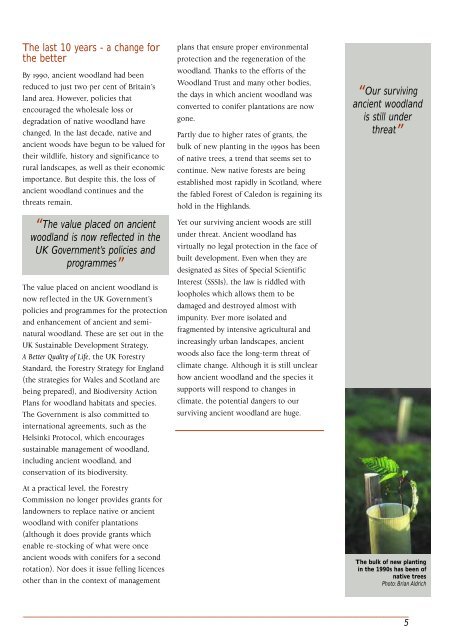Ancient Woodland Threats - Woodland Trust
Ancient Woodland Threats - Woodland Trust
Ancient Woodland Threats - Woodland Trust
You also want an ePaper? Increase the reach of your titles
YUMPU automatically turns print PDFs into web optimized ePapers that Google loves.
The last 10 years - a change for<br />
the better<br />
By 1990, ancient woodland had been<br />
reduced to just two per cent of Britain’s<br />
land area. However, policies that<br />
encouraged the wholesale loss or<br />
degradation of native woodland have<br />
changed. In the last decade, native and<br />
ancient woods have begun to be valued for<br />
their wildlife, history and significance to<br />
rural landscapes, as well as their economic<br />
importance. But despite this, the loss of<br />
ancient woodland continues and the<br />
threats remain.<br />
“ The value placed on ancient<br />
woodland is now reflected in the<br />
UK Government’s policies and<br />
programmes”<br />
The value placed on ancient woodland is<br />
now ref lected in the UK Government’s<br />
policies and programmes for the protection<br />
and enhancement of ancient and seminatural<br />
woodland. These are set out in the<br />
UK Sustainable Development Strategy,<br />
A Better Quality of Life, the UK Forestry<br />
Standard, the Forestry Strategy for England<br />
(the strategies for Wales and Scotland are<br />
being prepared), and Biodiversity Action<br />
Plans for woodland habitats and species.<br />
The Government is also committed to<br />
international agreements, such as the<br />
Helsinki Protocol, which encourages<br />
sustainable management of woodland,<br />
including ancient woodland, and<br />
conservation of its biodiversity.<br />
At a practical level, the Forestry<br />
Commission no longer provides grants for<br />
landowners to replace native or ancient<br />
woodland with conifer plantations<br />
(although it does provide grants which<br />
enable re-stocking of what were once<br />
ancient woods with conifers for a second<br />
rotation). Nor does it issue felling licences<br />
other than in the context of management<br />
plans that ensure proper environmental<br />
protection and the regeneration of the<br />
woodland. Thanks to the efforts of the<br />
<strong>Woodland</strong> <strong>Trust</strong> and many other bodies,<br />
the days in which ancient woodland was<br />
converted to conifer plantations are now<br />
gone.<br />
Partly due to higher rates of grants, the<br />
bulk of new planting in the 1990s has been<br />
of native trees, a trend that seems set to<br />
continue. New native forests are being<br />
established most rapidly in Scotland, where<br />
the fabled Forest of Caledon is regaining its<br />
hold in the Highlands.<br />
Yet our surviving ancient woods are still<br />
under threat. <strong>Ancient</strong> woodland has<br />
virtually no legal protection in the face of<br />
built development. Even when they are<br />
designated as Sites of Special Scientific<br />
Interest (SSSIs), the law is riddled with<br />
loopholes which allows them to be<br />
damaged and destroyed almost with<br />
impunity. Ever more isolated and<br />
fragmented by intensive agricultural and<br />
increasingly urban landscapes, ancient<br />
woods also face the long-term threat of<br />
climate change. Although it is still unclear<br />
how ancient woodland and the species it<br />
supports will respond to changes in<br />
climate, the potential dangers to our<br />
surviving ancient woodland are huge.<br />
“ Our surviving<br />
ancient woodland<br />
is still under<br />
threat”<br />
The bulk of new planting<br />
in the 1990s has been of<br />
native trees<br />
Photo: Brian Aldrich<br />
5


